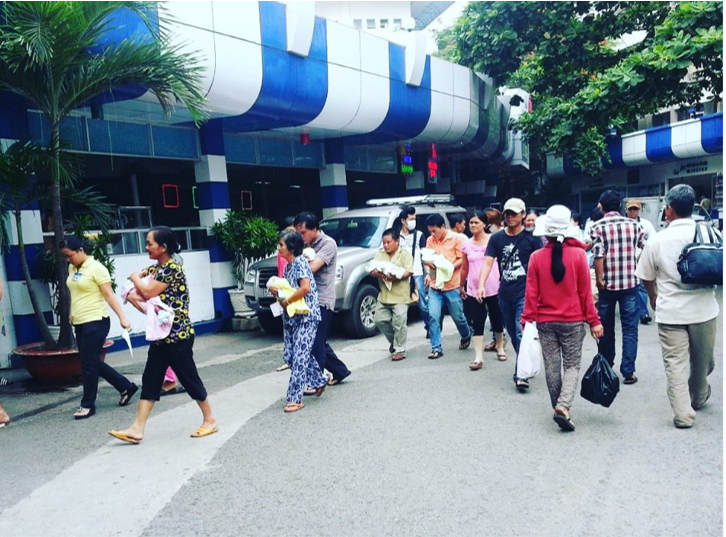

June 2013 Article: The Genesis of Our Engagement with Ho Chi Minh City's District 1 Pediatric Clinic.
This article from June 2013 marks the beginning of our involvement with a pediatric clinic in District 1 of Ho Chi Minh City, Vietnam, predating our investment. It recounts our experiences during the initial marketing phase.
Dr. Nee, a pediatrician at Tu Du Hospital in Ho Chi Minh City and an alumnus of Shiga University Medical School in Japan, represents the young demographics of Vietnam, where the average age is 27.4 years, and 70% of the population is under 35. Tu Du Hospital sees about 50,000 births annually, resulting in high demand for pediatric services. Dr. Nee alone consults between 100 and 150 pediatric rehabilitation patients daily. The hospital resembles a field hospital, with outpatient services and a pharmacy located outside.
Considering the perinatal and pediatric conditions in Vietnam, which are hard to imagine in Japan, the current population of around 90 million is expected to exceed 100 million by early 2020.
During this visit, Dr. Kondo, President of Meiseikai, who had frequently visited Vietnam for medical meetings, initially considered introducing Japanese endoscopy technology. However, he concluded that the real need was for obstetrics and pediatrics.
In Ho Chi Minh, the wealthy often seek care in Singapore or at the French-Vietnamese Hospital when something minor arises, highlighting the economic disparity. However, we believe that Vietnam's healthcare, though not on par with Japan’s, is progressing and may soon catch up.
The Vice Director of Nido Hospital, a pediatric specialist hospital we later visited, expressed a need for more medical facilities and employment for Vietnamese doctors. They suggested Japanese doctors could contribute in an advisory role, considering their high remuneration and Vietnam's ten medical universities.
With physicians’ salaries ranging from 200,000 to 300,000 yen (ten times the average income), it's challenging for Japanese doctors to work in Vietnam long-term outside of volunteer work. Although some hospitals in China offer lucrative packages to Japanese doctors, such a scenario seems unlikely in Vietnam.
The need is to adapt to the local context and contribute to Vietnamese healthcare while showcasing Japan's medical excellence. Some Japanese funds have already begun collaborations with local hospitals, building new facilities. However, Japanese medical corporations face barriers and delays in obtaining government permissions to operate independently.
Our role might be to partner with local hospitals to establish medical facilities that serve the community. The Ministry of Economy, Trade and Industry (METI) sees healthcare as part of its outbound strategy.
We plan to submit a proposal by July and start exploring business models in August. We aim to remember these insights and propose small pediatric and obstetrics clinics that offer uniquely Japanese medical care, in collaboration with multiple Japanese doctors. (Written by: Yuji Ishii)
This article from June 2013 marks the beginning of our involvement with a pediatric clinic in District 1 of Ho Chi Minh City, Vietnam, predating our investment. It recounts our experiences during the initial marketing phase.
Dr. Nee, a pediatrician at Tu Du Hospital in Ho Chi Minh City and an alumnus of Shiga University Medical School in Japan, represents the young demographics of Vietnam, where the average age is 27.4 years, and 70% of the population is under 35. Tu Du Hospital sees about 50,000 births annually, resulting in high demand for pediatric services. Dr. Nee alone consults between 100 and 150 pediatric rehabilitation patients daily. The hospital resembles a field hospital, with outpatient services and a pharmacy located outside.
Considering the perinatal and pediatric conditions in Vietnam, which are hard to imagine in Japan, the current population of around 90 million is expected to exceed 100 million by early 2020.
During this visit, Dr. Kondo, President of Meiseikai, who had frequently visited Vietnam for medical meetings, initially considered introducing Japanese endoscopy technology. However, he concluded that the real need was for obstetrics and pediatrics.
In Ho Chi Minh, the wealthy often seek care in Singapore or at the French-Vietnamese Hospital when something minor arises, highlighting the economic disparity. However, we believe that Vietnam's healthcare, though not on par with Japan’s, is progressing and may soon catch up.
The Vice Director of Nido Hospital, a pediatric specialist hospital we later visited, expressed a need for more medical facilities and employment for Vietnamese doctors. They suggested Japanese doctors could contribute in an advisory role, considering their high remuneration and Vietnam's ten medical universities.
With physicians’ salaries ranging from 200,000 to 300,000 yen (ten times the average income), it's challenging for Japanese doctors to work in Vietnam long-term outside of volunteer work. Although some hospitals in China offer lucrative packages to Japanese doctors, such a scenario seems unlikely in Vietnam.
The need is to adapt to the local context and contribute to Vietnamese healthcare while showcasing Japan's medical excellence. Some Japanese funds have already begun collaborations with local hospitals, building new facilities. However, Japanese medical corporations face barriers and delays in obtaining government permissions to operate independently.
Our role might be to partner with local hospitals to establish medical facilities that serve the community. The Ministry of Economy, Trade and Industry (METI) sees healthcare as part of its outbound strategy.
We plan to submit a proposal by July and start exploring business models in August. We aim to remember these insights and propose small pediatric and obstetrics clinics that offer uniquely Japanese medical care, in collaboration with multiple Japanese doctors. (Written by: Yuji Ishii)
- Categories
- Asian Healthcare Blog

